How can you not love a name like Finnegan Biden? I find it charming when family names are given fresh life in ensuing generations, and that’s exactly what happened in the lineage bracketing Vice President Joe Biden. His beloved mother Jean’s full name was Catherine Eugenia Finnegan Biden. Subtract “Catherine Eugenia” and you have the name of one of his granddaughters – Finnegan Biden. Whether she knows it or not, there’s a lot of history tucked into her first name.
My guess is that she’s heard some of it from her grandfather, who likes to tell tales about his own grandfather Ambrose Finnegan, but she probably doesn’t know everything I’m about to share. As a professional genealogist, I’m something of a retro-journalist who delves into people’s family histories, and given my own Irish roots, I have a soft spot for anyone who shares that heritage – from Barack Obama to Barry Manilow. So I suppose it was inevitable that Vice President Biden would take a turn under my past-seeking microscope. Before probing more deeply, let’s step back and take a look at the big picture – well, the Irish part of that picture.
By heritage, Joe Biden is roughly five-eighths Irish. His mother’s entire family tree traces to Ireland with ancestors named Arthurs, Blewitt, Boyle, Roche, Scanlon and Stanton accompanying her Finnegan kin. The last one-eighth comes from his father’s side, which contributed the Hanafee name.
Most of the immigrants in the Vice President’s family were born in the early decades of the 19th century and made the journey to America mid-century, so the Famine was undoubtedly a key factor in their departure. With a couple of exceptions, they converged almost immediately on Scranton, Pennsylvania. By the time the future Vice President joined the family in 1942, they had been settled there for roughly 70 to 90 years, so it’s little wonder that Scranton features so prominently in his narrative.
Biden’s quintessentially Irish American mother was born in 1917 to Ambrose Finnegan and Geraldine Blewitt, so it seems appropriate to focus on the Finnegan and Blewitt branches that played such a strong role in shaping who he would become.
The Blewitts of County Mayo
In his Blewitt line, it was Biden’s great-great-great-grandfather, Edward, who made the decision to emigrate to America in 1851, though he may have been influenced by his son, Patrick (Biden’s eventual great-great-grandfather). Joining his parents and seven siblings on the voyage, 18-year-old Pat is recorded as a sailor on the ship’s manifest, but that was only part of the story. Though still a teenager, he had already worked as a cabin boy and lived in Chile, and there are hints that he may have previously been to the United States.

Passenger list for the Excelsior showing Ed Blewitt and his wife and children arriving in New York on January 28, 1851
I’ve long believed that families pass more than just physical traits through the generations, and the Blewitts are a classic example. A number of the Blewitt men, for instance, worked as surveyors with a focus on civil and mining engineering. Another common denominator? Wanderlust. Though Patrick centered his life in his adopted hometown of Scranton, his work took him everywhere from Iowa to Brazil at a time when most regarded such trips as once-in-a-lifetime experiences. This explains why his eldest – Biden’s future great-grandfather, Edward – was born in New Orleans in 1859.
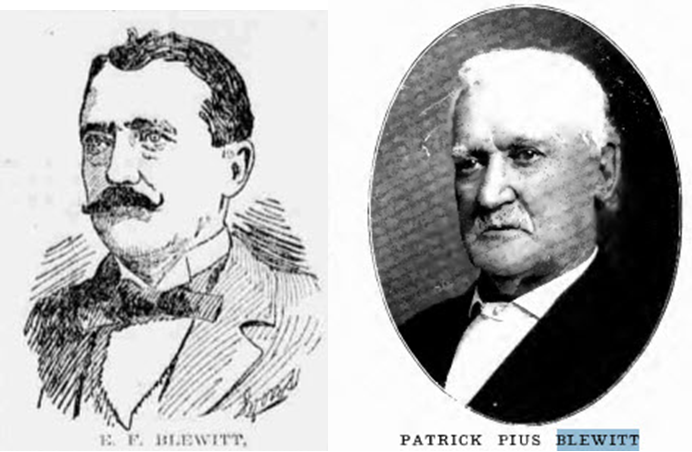
Biden’s great-grandfather, Edward Francis Blewitt (Scranton Tribune, 18 March 1897, as seen on www.chroniclingamerica.loc.gov) and Ballina-born great-great-grandfather, Patrick Blewitt (from Prominent Men: Scranton and Vicinity by Dwight J. Stoddard, 1906, as seen on oldforgecoalmine.com).
Edward inherited these occupational and meandering tendencies, putting in a decade as city engineer for Scranton before venturing to Mexico for a couple of years to oversee the construction of a drainage system and water works – 138 miles of sewers and 90 miles of pipes – for Guadalajara and the state of Jalisco. In a sign of things to come, Edward also waded into the world of politics, serving as a senator for the 22nd District in the Pennsylvania State Legislature. He was elected in 1907 and is believed to have been the first Irish American senator in the state.
Sadly, tragedy also links Edward with his famous descendant, as both lost their first wives at a young age. In 1972, a few weeks after Biden had been elected to the Senate, his first wife, Neilia, and their one-year-old daughter, Naomi, were killed in an auto accident. His sons also injured, Biden was sworn in at their hospital bedside. Mary Ellen (Stanton) Blewitt died of typhoid fever at age 27, leaving 29-year-old Edward widowed with several children including Biden’s future grandmother, Geraldine, and her sister, Gertie, who would also figure in Biden’s life in later years.
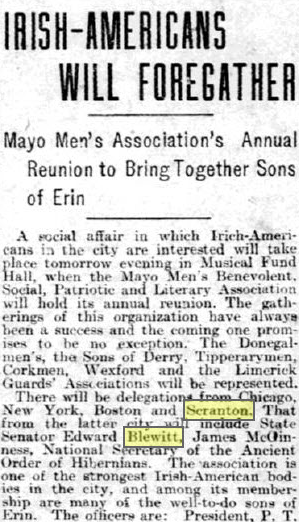
Philadelphia Inquirer, 25 October 1908 (as found on GenealogyBank.com, courtesy of NewsBank, Inc.)
The Blewitts’ pride in their heritage can be seen in Edward’s prominence in organizations including the Ancient Order of Hibernians (for which he chaired Scranton’s 1897 St. Patrick’s Day Parade), the Irish American Association (founded at his suggestion and now known as The Friendly Sons of Saint Patrick of Lackawanna County), and the Mayo Men’s Benevolent, Social, Patriotic and Literary Association.
The name of this latter society provides a fairly conspicuous clue to the origins of the Blewitt family, and they were indeed from County Mayo. Specifically, they were from the Ballina area, which is fitting as Scranton and Ballina happen to be sister cities. It’s difficult to pinpoint the precise location because various branches of an extended family tended to recycle the same first names with great regularity, but Patrick’s obituary mentions Ardagh Parish. An April 1832 baptism for “Patt Bluet” with parents named Edward and Mary can be found in the neighboring Kilmoremoy Parish, and this fits rather nicely with the 18-year-old who arrived in New York with the rest of his family in 1851.
A number of Blewitts remain in the Ballina region today. One of them, Brendan Blewitt, fondly remembers a visit from Biden’s mother in the late 1970s. Records from the critical timeframe are patchy, but it appears that Brendan and the Vice President are likely fourth or fifth cousins.
As it happens, former Irish President Mary Robinson, whose maiden name is Bourke, also hails from Ballina, and given that Brendan’s sister married a Bourke, it’s possible that Joe Biden and Mary Robinson are related by marriage. Were they to meet in Ballina, that would undoubtedly be one of the most memorable reunions of The Gathering.
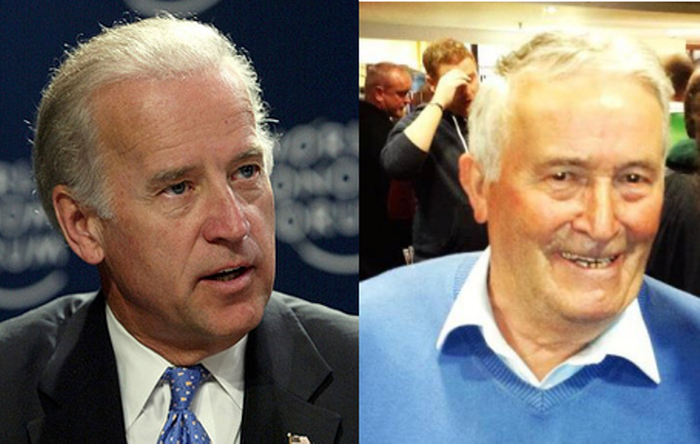
Family resemblance? Brendan Blewitt met Joe Biden’s mother during a roots-seeking trip she took to Ireland (photo on right courtesy of Laurita Blewitt).
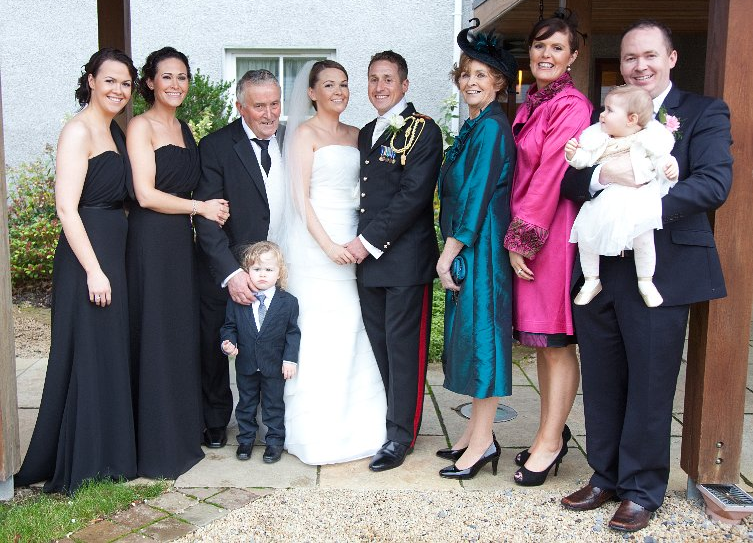
County Mayo Blewitt cousins (from left to right): Laurita, Catherina, Brendan, Dara, bride Brenda and her husband, Ross Dunphy, Christina, Deirdre, baby Emily and Joseph
The Finnegans of County Louth
Barack Obama’s Kearney forebears came to America from the town of Moneygall, in Co. Offaly, a fact widely known since the President’s pint-in-a-pub visit to his ancestral hometown, and it’s interesting to note the similarity to the Vice President’s family migration. In the case of Biden’s Finnegan line, the immigrant was Owen, his great-great-grandfather, and just as with Obama’s Kearneys, the patriarch came to America before the rest of his family. In fact, Owen Finnegan arrived in New York on May 31, 1849, just five weeks after Joseph Kearney, Obama’s ancestor. Curiously, both men were shoemakers.
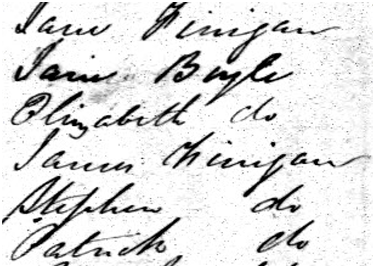
Jane Finnegan arrived in New York with her children and some Boyle relatives in 1850
Owen’s wife, Jane, followed with their children (including Biden’s great-grandfather, James) almost a year later in May 1850 on a ship called the Marchioness of Bute, meaning that the Finnegans beat the Blewitts to America by about eight months. Unlike the Blewitts, however, the Finnegans did not sprint directly to Scranton. The 1850 census, conducted mere months after their arrival, finds them in Covert, New York. Before long, they shifted slightly north to the town of Ovid. Parents Owen and Jane stayed put and were eventually buried there, but their children scattered.
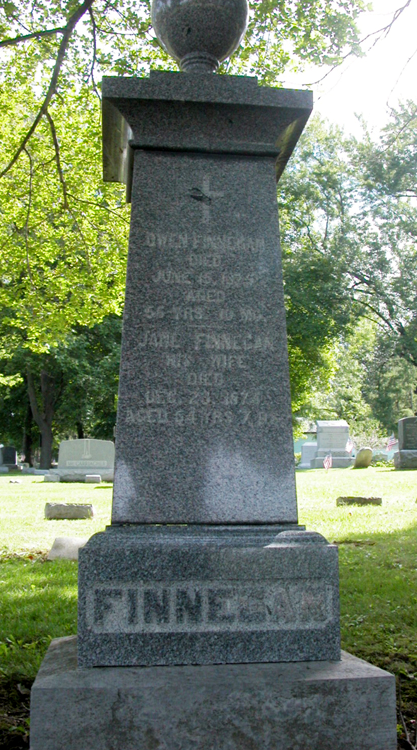
Several of the immigrant Finnegans are buried in Holy Cross Cemetery in Ovid, New York
They lost one son, Michael, to the Civil War, at Cold Harbor, Virginia in 1864. Another named Stephen was wounded at Spotsylvania Courthouse and carried shrapnel souvenirs for the rest of his life. Stephen and two of his brothers went to California, while other siblings settled in Ohio and Missouri.
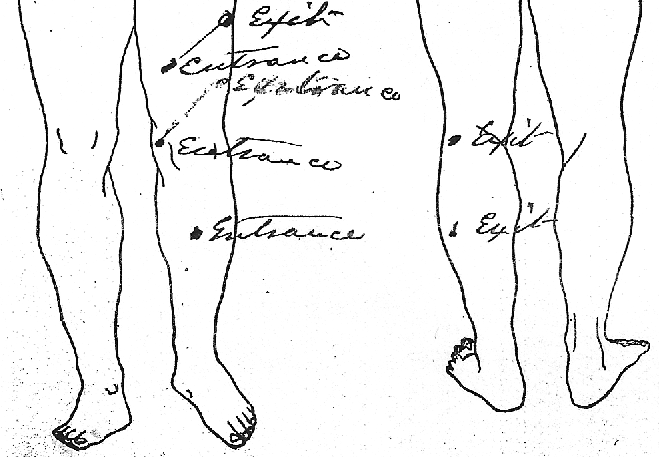
Entrance and exit wounds on the left leg of Biden’s great-granduncle, Stephen Finnegan, who served in the Civil War (as seen in his pension file from the National Archives and Records Administration)
It was Owen and Jane’s son James who stayed the closest to home, and census records provide a hint as to why this might have been. Two of the four records that include him state that he was blind. This inconsistency suggests that while he may not have been completely blind, he probably had a severe vision problem of some sort, which would explain why he didn’t serve in the Civil War or follow the family’s preferred occupation of shoemaker. Instead, he became a musician.
After marrying Catherine Roche in 1866 and living in Rochester, New York for several years, James moved to Olyphant, situated on the outskirts of Scranton, Pennsylvania. His wife’s brother, Peter, also lived there, which would prove fortunate for the couple’s youngest son, Ambrose, born in 1884.
Ambrose, the future grandfather who would provide both fodder and inspiration for Biden, had a rough start in life, with his mother passing away before his second birthday and his father dying when he was ten. Just two days before his death, James wrote a will leaving his prized violin to Ambrose, a snippet of information that revealed that he had literally been a blind fiddler.

James Finnegan left his violin to his son, Ambrose, and income to a local orphanage
He also instructed that his house be held a year before selling, and that the “rent or income of my property . . . be paid . . . to the St. Patrick’s Orphanage of Scranton, PA until said real estate is legally disposed of or sold.” The orphanage in question was opened shortly after the Finnegans arrived in Scranton, and made national news in 1881 when 17 children died in a fire. The local community rallied to rebuild, and the Finnegans were among those who supported the effort, but knowing that James was aware that he would soon be leaving his youngest an orphan makes this final bequest all the more poignant.
Ambrose moved in with the family of his maternal uncle, Peter Roche, and remained close to them, even working for the Roche Company, which manufactured signs and bulletin boards. That they were devout Catholics is hinted at by the fact that Ambrose’s slightly older cousin, Thomas Roche, went abroad on more than one occasion with the Knights of Columbus.
It was on June 1, 1909 that the Finnegan and Blewitt families finally linked destinies, when Ambrose Joseph Finnegan married Geraldine Catherine Blewitt. Their first born was a honeymoon baby, which may be what motivated the freshly minted husband and father to put in a season as a census enumerator in 1910. As a result, should the Vice President ever wish to see a sample of his grandfather’s handwriting, all he has to do is scan the pages of the 1910 federal census for Dunmore Borough in Lackawanna County.

Ambrose Finnegan’s signature can be seen in the upper right of many 1910 census pages
As with the immigrant Finnegans, Ambrose and Geraldine also sacrificed a son to war when Second Lieutenant Ambrose J. Finnegan, Jr. was killed in May 1944. The plane he was flying has never been located, so he is considered MIA/KIA. Having assisted the Army and JPAC (Joint POW/MIA Accounting Command) for 14 years with repatriation efforts to identify soldiers who are still unaccounted for from past conflicts, it was immediately apparent to me that should his uncle’s plane or remains ever be recovered, Vice President Biden would be eligible to provide a DNA reference sample to help in the process, and given his family’s proud military history, I suspect he would.
Little Joey Biden made his entrance the year after Ambrose and Geraldine’s daughter, Jean, married Joseph Biden, making him a fifth-generation Finnegan in the United States, but just where in Ireland did they come from?
The ships they journeyed on left from Newry, so that provided a clue, and working with Griffith’s Valuation narrowed the search to counties Armagh, Louth, Cavan, Monaghan and Meath. I knew that James Finnegan was born around 1840 with parents named Owen Finnegan and Jane Boyle, who would have probably married in the late 1830s, since James was their eldest. Considerable digging eventually unearthed a James baptized on December 18, 1840 in Lordship Parish in County Louth with parents named “Owen Finegan” and “Jean Bail” (likely a distortion of Boyle as Griffith’s Valuation shows no Bail families).
Owen and Jane had married on December 8, 1839 in Cooley Parish, County Louth. The records involved are all Roman Catholic and the parishes border each other, indicating an origin in the vicinity of Carlingford, so should Joe Biden decide to pay tribute to his Grandpa Finnegan, County Louth can expect a visit.
Not surprisingly, that visit would be welcomed. Upon learning of the connection, Kevin Woods, a member of the County Louth Gathering Steering Committee, declared, “We are going to move heaven and earth to get Vice President Biden here.” But even aside from the Blewitt homeland of County Mayo, there’s some competition. Bono of U2 is trying to tempt the Vice President to visit his own stomping grounds of Dalkey on the edge of Dublin. “He’s a Finnegan,” said Bono. “His mother was a Finnegan, which is the name of my local pub, so I have to introduce him to my local publican.” As persuasive as the famed singer and humanitarian may be, I wouldn’t bet on him in this particular instance.

Owen Finigan and Jane Boyle married in Cooley Parish in 1839
An Unexpected Call
I first began poking into Joe Biden’s past before he became Vice President, and have shared bits and pieces of my discoveries online over the years. Even so, it caught me by surprise when I answered the phone one day last summer to hear the caller say, “This is Joe Biden. Vice President Joe Biden.” That he troubled to explain who he is may well be a reflection of the values he inherited from Grandpa Finnegan and others, including his great-aunt Gertrude, who wound up at the heart of our conversation that day. Gertie, it turns out, gave terrific back rubs, made the best rice pudding you ever tasted, and frequently reminded Joey to be proud of his Irish heritage. Rest assured he is, Aunt Gertie, and I think it’s safe to say the Irish are proud of Joey, too.
![]()
This article originally appeared in the April-May 2013 issue of Irish America magazine (pages 56-59). The inscription reads, “Megan, I truly appreciate what you’ve done for me. My Mom would be so very proud. Love ya! — Joe Biden”.
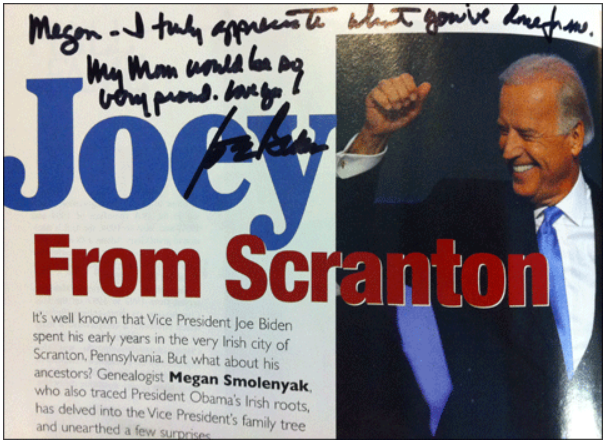

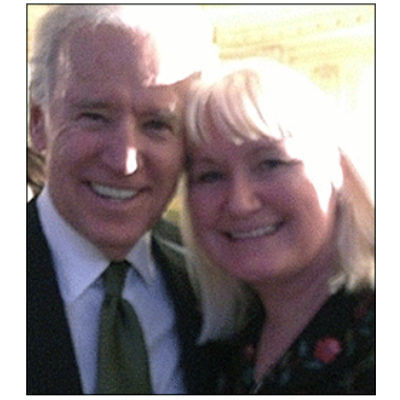
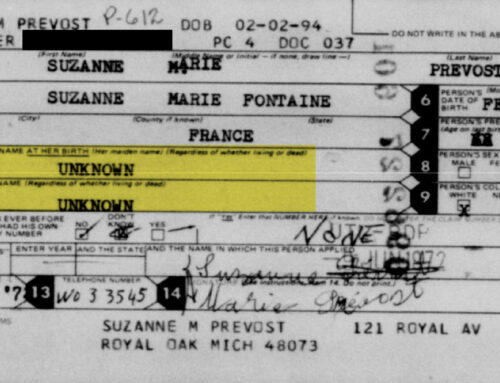
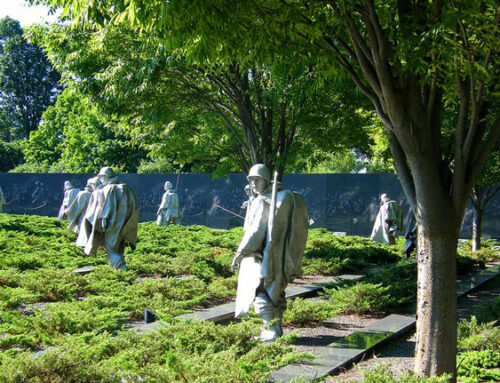
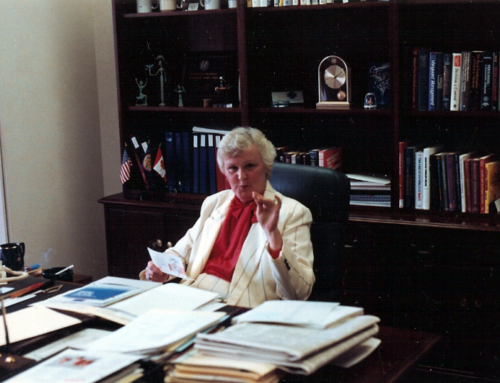

Leave A Comment